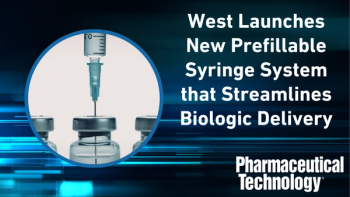
- Pharmaceutical Technology-06-02-2008
- Volume 32
- Issue 6
A Broad Palette for Biological Drug Delivery
Although the spotlight is now on nanoparticulate delivery for biologicals, other strategies have proven successful.
Nanoparticles are the center of many drug-delivery specialists' attention because they can form the basis of mechanisms that provide targeted and controlled drug delivery. Because nanoparticles also enhance drug stability and reduce immunogenicity, they provide a particularly advantageous solution for biological drugs. But they are not the only option on the table.
One common approach to delivering protein drugs is to attach polyethylene glycol (PEG) molecules to their amine groups. This process is called PEGylation. Anjan Nan, research assistant professor at the University of Maryland School of Pharmacy (Baltimore, MD), says that this technique has several advantages.
First, PEGylation reduces the protein's net amount of available amine groups, thus decreasing its net charge. "As a result, the whole formulation is less immunogenic because the body doesn't react to that excessive charge," Nan explains. "This is an easy and efficient strategy to make immunogenic molecules nonimmunogenic."
The hydrophilic nature of PEG molecules also reduces immunogenicity. Once a PEG molecule is bound to a protein, it attracts water molecules. This hydration reduces the likelihood that the body's immune system will recognize the molecule as a foreign object, Nan says.
PEGylation makes proteins more stable, too. In general, PEGylation reduces the plasma-clearance rate by decreasing the metabolic degradation and receptor-mediated uptake of the protein from the systemic circulation. Conjugating PEG to proteins results in lower protein aggregation, reduced protein adsorption, and protects against antigenic and immunogenic epitopes.
Nan adds that PEGylation can also provide targeted delivery of protein drugs because it increases their molecular size. Big molecules move toward sites such as tumors and inflammations because those areas have leaky vasculature. "You can take advantage of such a macromolecular delivery system to selectively deliver to the site of action," says Nan.
Dr. Frank Sorgi, vice-president of research and development at DPT (San Antonio, TX), acknowledges PEGylation's benefits, but counters that PEG molecules can also prevent the drug from being taken up by the body. As is the case with other drug-delivery strategies, PEGylation requires scientists to find a trigger that cleaves the protecting or targeting molecules from the drug at the site of absorption. Current techniques may include using pH, heat, light, or the administration of other components. "You can see just how complex this gets because you need to build up and then tear down the molecular complex to make it biologically active," remarks Sorgi.
Microparticle-based systems such as MannKind's (Valencia, CA) "Technosphere" technology employ a different drug-delivery strategy for biologicals. The technology involves loading drugs onto fumaryl diketopiperazine (FDKP) microparticles for pulmonary delivery. Upon inhalation, the Technosphere particles travel to the deep lung, where they dissolve immediately. Technosphere particles do not play an active role in drug absorption, explains Peter Richardson, MannKind's chief scientific officer. Instead, the FDKP and the drug are absorbed by natural mechanisms. The FDKP is excreted unmetabolized, primarily in the urine, and the drug enters the systemic circulation.
Technosphere technology could enable the pulmonary administration of therapeutics currently administered by injection. According to Richardson, the technique offers several advantages over other pulmonary drug-delivery systems. For example, drugs inhaled as Technosphere formulations have pharmacokinetic profiles that result from rapid systemic absorption from the lung directly into the arterial circulation. Technosphere delivery also bypasses first-pass metabolism.
MannKind's research has demonstrated that insulin can be stabilized in the monomer form when formulated with Technosphere particles. The technology thus "has the potential to allow the development of drug candidates that would not otherwise be feasible," says Richardson.
In addition, the technology is compatible with drugs that have various physicochemical characteristics. "Drugs that are anionic, cationic, hydrophobic, hydrophilic, and those with high molecular weight have all been delivered using Technosphere technology in preclinical models," Richardson says. In addition, the technology has been used successfully to prepare formulations of drugs with molecular weights of 500–140,000 Da.
The pharmaceutical industry's interest in biological drugs is growing, partly because of these therapies' promise for improving treatment for patients, and partly because they could boost companies' dwindling pipelines. Protein-based drugs, and their interactions inside the body, are complex, but science's understanding of them is growing. Even now, drugmakers have various effective drug-delivery options to choose from. Researchers such as Nan and companies such as MannKind give reason for optimism that the industry can overcome the challenges that biological therapies pose.
For more on this topic, see"
Articles in this issue
over 17 years ago
Healthcare Reform Proposals Challenge Manufacturersover 17 years ago
The Use of Complainingover 17 years ago
Pharma Capsulesover 17 years ago
PDA Takes On Risks for Patientsover 17 years ago
Cell Manufacturing on a Large Scaleover 17 years ago
In the Spotlight June 2008over 17 years ago
Innovations at INTERPHEX: Part 2over 17 years ago
Small Wonder: Nanoparticle Strategies for Biological DrugsNewsletter
Get the essential updates shaping the future of pharma manufacturing and compliance—subscribe today to Pharmaceutical Technology and never miss a breakthrough.




